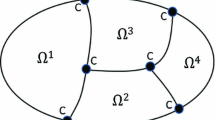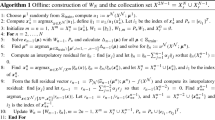Abstract
A state-defect constraint pairing graph coarsening method is described for improving computational efficiency during the numerical factorization of large sparse Karush–Kuhn–Tucker matrices that arise from the discretization of optimal control problems via an Legendre–Gauss–Radau orthogonal collocation method. The method takes advantage of the particular sparse structure of the Karush–Kuhn–Tucker matrix that arises from the orthogonal collocation method. The state-defect constraint pairing graph coarsening method pairs each component of the state with its corresponding defect constraint and forces paired rows to be adjacent in the reordered Karush–Kuhn–Tucker matrix. Aggregate state-defect constraint pairing results are presented using a wide variety of benchmark optimal control problems where it is found that the proposed state-defect constraint pairing graph coarsening method significantly reduces both the number of delayed pivots and the number of floating point operations and increases the computational efficiency by performing more floating point operations per unit time. It is then shown that the state-defect constraint pairing graph coarsening method is less effective on Karush–Kuhn–Tucker matrices arising from Legendre–Gauss–Radau collocation when the optimal control problem contains state and control equality path constraints because such matrices may have delayed pivots that correspond to both defect and path constraints. An alternate graph coarsening method that employs maximal matching is then used to attempt to further reduce the number of delayed pivots. It is found, however, that this alternate graph coarsening method provides no further advantage over the state-defect constraint pairing graph coarsening method.

















Similar content being viewed by others
References
Gill, P.E., Murray, W., Saunders, M.A.: SNOPT: an SQP algorithm for large-scale constrained optimization. SIAM J. Optim. 12(4), 979–1006 (2002)
Biegler, L.T., Zavala, V.M.: Large-scale nonlinear programming using IPOPT: an integrating framework for enterprise-wide dynamic optimization. Comput. Chem. Eng. 33(3), 575–582 (2009)
Duff, I.S., Reid, J.K.: MA47, A Fortran Code for Direct Solution of Indefinite Sparse Symmetric Linear Systems. Report RAL, pp. 95–001 (1995)
Duff, I.S.: MA57—a code for the solution of sparse symmetric definite and indefinite systems. ACM Trans. Math. Softw. 30(2), 118–144 (2004)
Amestoy, P.R., Duff, I.S., L’Excellent, J.-Y., Koster, J.: MUMPS: A General Purpose Distributed Memory Sparse Solver. Springer, Heidelberg (2001)
Schenk, O., Gärtner, K.: Two-level dynamic scheduling in PARDISO: improved scalability on shared memory multiprocessing systems. Parallel Comput. 28(2), 187–197 (2002)
Elnagar, G., Kazemi, M., Razzaghi, M.: The pseudospectral legendre method for discretizing optimal control problems. IEEE Trans. Autom. Control 40(10), 1793–1796 (1995)
Elnagar, G., Razzaghi, M.: A collocation-type method for linear quadratic optimal control problems. Optim. Control Appl. Methods 18(3), 227–235 (1998)
Fahroo, F., Ross, I.M.: Costate estimation by a legendre pseudospectral method. J. Guidance Control Dyn. 24(2), 270–277 (2001)
Fahroo, F., Ross, I.M.: Direct trajectory optimization by a Chebyshev pseudospectral method. J. Guidance Control Dyn. 25(1), 160–166 (2002)
Benson, D.A., Huntington, G.T., Thorvaldsen, T.P., Rao, A.V.: Direct trajectory optimization and costate estimation via an orthogonal collocation method. J Guidance Control Dyn. 29(6), 1435–1440 (2006)
Huntington, G.T., Benson, D.A., Rao, A.V.: Optimal configuration of tetrahedral spacecraft formations. J. Astronaut. Sci. 55(2), 141–169 (2007)
Huntington, G.T., Rao, A.V.: Optimal reconfiguration of spacecraft formations using the Gauss pseudospectral method. J Guidance Control Dyn. 31(3), 689–698 (2008)
Gong, Q., Fahroo, F., Ross, I.M.: Spectral algorithm for pseudospectral methods in optimal control. J Guidance Control Dyn. 31(3), May–June (2008)
Gong, Q., Ross, I.M., Kang, W., Fahroo, F.: Connections between the covector mapping theorem and convergence of pseudospectral methods. Comput. Optim. Appl. 41(3), 307–335 (2008)
Rao, A.V., Benson, D.A., Darby, C.L., Francolin, C., Patterson, M.A., Sanders, I., Huntington, G.T.: Algorithm 902: GPOPS, a matlab software for solving multiple-phase optimal control problems using the Gauss pseudospectral method. ACM Trans. Math. Softw. 37(2), Article 22, 39 pp., April–June (2010)
Darby, C.L., Hager, W.W., Rao, A.V.: An \(hp\)-adaptive pseudospectral method for solving optimal control problems. Optim. Control Appl. Methods 32(4), 476–502 (2011)
Darby, C.L., Hager, W.W., Rao, A.V.: Direct trajectory optimization using a variable low-order adaptive pseudospectral method. J. Spacecr. Rockets 48(3), 433–445 (2011)
Kameswaran, S., Biegler, L.T.: Convergence rates for direct transcription of optimal control problems using collocation at radau points. Comput. Optim. Appl. 41(1), 81–126 (2008)
Garg, D., Patterson, M.A., Darby, C.L., Francolin, C., Huntington, G.T., Hager, W.W., Rao, A.V.: Direct trajectory optimization and costate estimation of finite-horizon and infinite-horizon optimal control problems via a radau pseudospectral method. Comput. Optim. Appl. 49(2), 335–358 (2011). doi:10.1007/s10589-00-09291-0
Garg, D., Patterson, M.A., Hager, W.W., Rao, A.V., Benson, D.A., Huntington, G.T.: A unified framework for the numerical solution of optimal control problems using pseudospectral methods. Automatica 46(11), 1843–1851 (2010). doi:10.1016/j.automatica.2010.06.048
Garg, D., Hager, W.W., Rao, A.V.: Pseudospectral methods for solving infinite-horizon optimal control problems. Automatica 47(4), 829–837 (2011). doi:10.1016/j.automatica.2011.01.085
Patterson, M.A., Rao, A.V.: GPOPS- II: A MATLAB software for solving multiple-phase optimal control problems using hp-adaptive Gaussian quadrature collocation methods and sparse nonlinear programming. ACM Trans. Math. Softw. 41(1), 1:1–1:37 (2014)
Patterson, M.A., Hager, W.W., Rao, A.V.: A \(ph\) mesh refinement method for optimal control. Optim. Control Appl. Methods 36(4), 398–421 (2015). doi:10.1002/oca2114
Francolin, C.C., Hager, W.W., Rao, A.V.: Costate approximation in optimal control using integral Gaussian quadrature collocation methods. Optim. Control Appl. Methods 36(4), 381–397 (2015). doi:10.1002/oca2112
Karypis, G., Kumar, V.: A fast and high quality multilevel scheme for partitioning irregular graphs. SIAM J. Sci. Comput. 20(1), 359–392 (1998)
Pothen, A., Simon, H.D., Wang, L., Barnard, S.T.: Towards a fast implementation of spectral nested dissection. In: Proceedings of the 1992 ACM/IEEE Conference on Supercomputing, pp. 42–51. IEEE Computer Society Press (1992)
Pothen, A., Simon, H.D., Liou, K.-P.: Partitioning sparse matrices with eigenvectors of graphs. SIAM J. Matrix Anal. Appl. 11(3), 430–452 (1990)
Miller, G.L., Teng, S.-H., Thurston, W., Vavasis, S.A.: Automatic Mesh Partitioning. Springer, Berlin (1993)
Miller, G.L., Teng, S.-H., Vavasis, S.A.: A unified geometric approach to graph separators. In: Proceedings., 32nd Annual Symposium on Foundations of Computer Science, pp. 538–547. IEEE (1991)
Cheng, C.-K., Wei, Y.-C.: An improved two-way partitioning algorithm with stable performance [VLSI]. IEEE Trans. Comput. Aided Des. Integr. Circuits Syst. 10(12), 1502–1511 (1991)
Hendrickson, B., Leland, R.W.: A Multi-level algorithm for partitioning graphs. SC 95, 28 (1995)
Mansour, N., Ponnusamy, R., Choudhary, A., Fox, G.: Graph contraction for physical optimization methods: a quality-cost tradeoff for mapping data on parallel computers. In: Proceedings of the 7th International Conference on Supercomputing, pp. 1–10. ACM (1993)
Cong, J., Shinnerl, J.R.: Multilevel Optimization in VLSICAD. Springer, Berlin (2003)
Safro, I., Sanders, P., Schulz, C.: Advanced Coarsening Schemes for Graph Partitioning, Experimental Algorithms. Springer, Berlin (2012)
Word, D.P., Kang, J., Akesson, J., Laird, C.D.: Efficient parallel solution of large-scale nonlinear dynamic optimization problems. Comput. Optim. Appl. 59, 667–688 (2014)
Patterson, M.A., Rao, A.V.: Exploiting sparsity in direct collocation pseudospectral methods for solving optimal control problems. J. Spacecr. Rocket. 49(2), 364–377 (2012)
Nocedal, J., Overton, M.L.: Projected Hessian updating algorithms for nonlinearly constrained optimization. SIAM J. Numer. Anal. 22(5), 821–850 (1985)
Sylvester, J.J.: XIX. A demonstration of the theorem that every homogeneous quadratic polynomial is reducible by real orthogonal substitutions to the form of a sum of positive and negative squares. Lond. Edinb. Dublin Philos. Magazine J. Sci. 4(23), 138–142 (1852)
Levenberg, K.: A method for the solution of certain problems in least squares. Q. Appl. Math. 2, 164–168 (1944)
Wächter, A., Biegler, L.T.: On the implementation of an interior-point filter line-search algorithm for large-scale nonlinear programming. Math. Progr. 106(1), 25–57 (2006)
Duff, I.S., Reid, J.K.: MA27–a set of Fortran subroutines for solving sparse symmetric sets of linear equations. UKAEA Atomic Energy Research Establishment (1982)
Duff, I.S., Reid, J.K.: The multifrontal solution of indefinite sparse symmetric linear. ACM Trans. Math. Softw. (TOMS) 9(3), 302–325 (1983)
Liu, J.W.: The multifrontal method for sparse matrix solution: theory and practice. SIAM Rev. 34(1), 82–109 (1992)
Betts, J.T.: Practical Methods for Optimal Control and Estimation Using Nonlinear Programming, vol. 19. SIAM Press, Philadelphia (2010)
Zhao, Y.J.: Optimal patterns of glider dynamic soaring. Optim. Control Appl. Methods 25(2), 67–89 (2004)
Goddard, R.H.: A method of reaching extreme altitudes. Nature 105, 809–811 (1920)
Ledzewicz, U., Schättler, H.: Analysis of optimal controls for a mathematical model of tumour anti-angiogenesis. Optim. Control Appl. Methods 29(1), 41–57 (2008)
Bryson, A.E.: Applied Optimal Control: Optimization, Estimation, and Control. CRC Press, New York (1975)
Bulirsch, R., Nerz, E., Pesch, H.J., von Stryk, O.: Combining Direct and Indirect Methods in Optimal Control: Range Maximization of a Hang Glider. Springer, Berlin (1993)
Sakawa, Y.: Trajectory planning of a free-flying robot by using the optimal control. Optim. Control Appl. Methods 20(5), 235–248 (1999)
Tinney, W.F., Walker, J.W.: Direct solutions of sparse network equations by optimally ordered triangular factorization. Proc. IEEE 55(11), 1801–1809 (1967)
Davis, T.A., Amestoy, P., Duff, I.S.: An approximate minimum degree ordering algorithm. SIAM J. Matrix Anal. Appl. 17(4), 886–905 (1996)
George, A.: Nested dissection of a regular finite element mesh. SIAM J. Numer. Anal. 10(2), 345–363 (1973)
Gibbs, N.E., Poole Jr, W.G., Stockmeyer, P.K.: An algorithm for reducing the bandwidth and profile of a sparse matrix. SIAM J. Numer. Anal. 13(2), 236–250 (1976)
Chan, W.-M., George, A.: A linear time implementation of the reverse Cuthill-McKee algorithm. BIT Numer. Math. 20(1), 8–14 (1980)
Amestoy, P.R., Davis, T.A., Duff, I.S.: Algorithm 837: AMD, an approximate minimum degree ordering algorithm. ACM Trans. Math. Softw. 30(3), 381–388 (2004)
Davis, T.A., Hu, Y.: The University of Florida sparse matrix collection. ACM Trans. Math. Softw. (TOMS) 38(1), 1 (2011)
Davis, T.A.: Direct Methods for Sparse Linear Systems, vol. 2. SIAM Press, Philadelphia (2006)
Acknowledgments
The authors gratefully acknowledge support for this research from the U.S. Office of Naval Research under Grants N00014-11-1-0068 and N00014-15-1-2048, from the U.S. National Science Foundation under Grants CBET-1404767 and DMS-1522629, and from the U.S. Space and Naval Warfare Systems Command under Grant N65236-13-1-1000.
Author information
Authors and Affiliations
Corresponding author
Rights and permissions
About this article
Cite this article
Cannataro, B.Ş., Rao, A.V. & Davis, T.A. State-defect constraint pairing graph coarsening method for Karush–Kuhn–Tucker matrices arising in orthogonal collocation methods for optimal control. Comput Optim Appl 64, 793–819 (2016). https://doi.org/10.1007/s10589-015-9821-x
Received:
Published:
Issue Date:
DOI: https://doi.org/10.1007/s10589-015-9821-x




